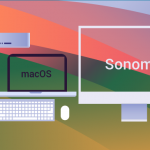
Macs have been a revolutionary presence in the computer market since their debut in the 1980s. They were the first mass-produced personal computers to feature a graphical user interface, a built-in 72 dpi screen, and a mouse. Later, Adobe built its design products exclusively for the Mac, cementing its place as the device of choice of the creative industry.
While its mass appeal dwindled with the rise of cheaper machines running on its main competitor’s operating system, Windows, Macs have continued to be a constant presence on the computer market due to their attractive design, high-quality hardware, and robust architecture.
In recent years, the rise of choose-your-own-device (CYOD) and bring-your-own-device (BYOD) policies have elevated Macs’ presence in the enterprise. A recent JAMF survey revealed that, when given the option, an impressive 72% of employees chose Apple devices over PCs. Apple’s own efforts to boost macOS security have shown the company’s commitment to Macs in the enterprise.
In 2020, Chrome OS took a big chunk of the global desktop computer market and surpassed macOS in sales volume to become the 2nd most popular operating system on newly purchased devices in the world. However, the rise of Chrome OS did not have a detrimental effect on macOS’s numbers but took users away from its main rival, Windows. In fact, Macs’ share of the global computer market continued to rise in 2020, reaching 7.5%, up from 6.7% in 2019.
However, when it comes to overall operating system usage, which covers all computers currently in use, macOS still ranks as second, accounting for 16.74% of desktop users. Chrome OS, meanwhile, as a relatively new operating system, only has 1.99% of the global market.
While Macs have become indispensable in the creative professionals across the world, their general adoption rate differs from country to country. Let’s take a closer look at some of the markets where macOS has had the biggest impact.
The United States
It is no surprise that Mac’s country of origin, the United States, where Apple has been a household name for the last forty years, is one of the biggest markets for Macs. 29.4% of desktop computer users in the United States use macOS as their operating system, the highest adoption rate in the Americas and one of the world’s highest.
The COVID-19 pandemic, which forced millions of people to stay at home to prevent the spread of infections, led to a boost in Macs’ sales in 2020 in the United States as technology began playing an increasingly important role in remote work and study. Parents in particular invested in new devices to support children’s need to attend classes and submit assignments online.
Singapore
While Japan saw a spectacular rise in Mac sales in 2020 due to the launch of the Mac Mini, accounting for 27.1% of all the country’s computer sales in November, it is the island-nation of Singapore that has the most macOS users in Asia. 23.7% of Singaporeans use a desktop computer running on macOS.
The United Kingdom
In Europe, it is the Scandinavian country of Denmark with the highest percentage of macOS users, accounting for an impressive 31.6% of all desktop computer users. Still, when it comes to sheer volume, it is the United Kingdom that wins due to the size of its population. 27.4% of British desktop computers in use run on macOS.
The United Kingdom saw a sharp increase in macOS adoption after the launch of macOS Catalina in October 2019, which introduced system extensions and a permanent move towards 64-bit applications.
In conclusion
Macs have staked a claim in the global desktop computer market. Their share is only likely to increase as Apple moves towards adopting its own line of chips and continues to invest in improving Mac’s competitiveness in the enterprise. However, as the number of macOS users increases, so does Macs’ attractiveness to cybercriminals. The chances of data loss and users and companies can no longer rely solely on Apple to ensure data security.
Download our free ebook on
Data Loss Prevention Best Practices
Helping IT Managers, IT Administrators and data security staff understand the concept and purpose of DLP and how to easily implement it.














